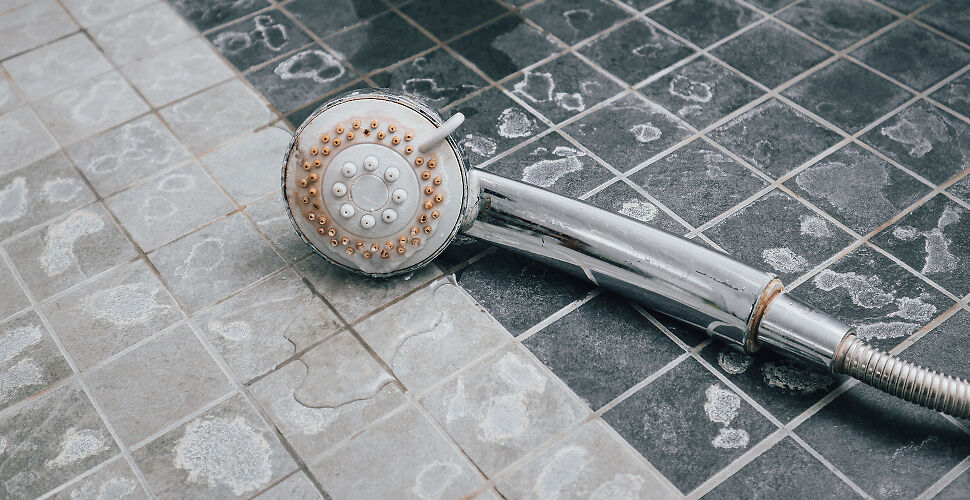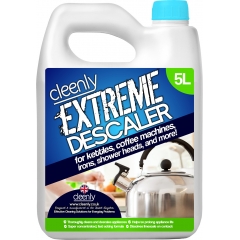
May 23rd, 2023 by
Appliances can be a pricey investment and we are often reliant on them in our day-to-day life, especially for things such as our kettles, washing machines, showers and taps. Unfortunately, appliances and fixtures such as this that use water are often subject to limescale build up which can not only be tricky to remove but can also heavily affect how well our appliances work and may even lead to their eventual breakdown. That’s why it is important to take steps to descale these items – in this blog, we will discuss the importance of descaling, tips for descaling and how often you should be including this in your cleaning routine.
What is Limescale?
Limescale which is also known as calcium carbonate or simply scale is a common occurrence around the home, and there is a chance you may have seen it on your taps, inside the kettle or even on the iron. It is a hard and chalky deposit that is often white or off-white in appearance. While it is primarily made up of calcium carbonate it may contain other mineral and impurities such as magnesium carbonate. that forms when water containing dissolved minerals evaporates or is heated. It consists mainly of calcium carbonate but can also contain other minerals such as magnesium carbonate and various impurities.

How Does Limescale Build Up?
Limescale forms when water containing these minerals evaporates or heats up, which is why it is often found in the kettle. It is also particularly common in areas with hard water, as these contain higher amounts of calcium and magnesium. So, when water is heated or allowed to evaporate the minerals in water are then left behind and this is what forms the hard, crusty deposit. This can often remain even after being cleaned, and as mentioned above is incredibly common in appliances that come in contact with water as well as faucets and pipes.
Why Does Limescale Need to Be Removed?
Limescale deposits should be removed for a number of reasons
Appearance:
Perhaps not the most important reason, but limescale can look unsightly and give an unclean appearance, this can be especially important in commercial areas such as cafes, hotels or restaurants.
Affects Performance of Appliances:
Failing to remove limescale can also affect the overall performance and longevity of your appliances causing them to prematurely break down. If you don't regularly remove limescale deposits from the inside of your machine, these deposits can build up to form hard-scale deposits these can then cause damage to internal parts of your machine over time and make it less efficient. For example, heating elements may not heat up as quickly or get as hot, causing irons to be less effective or kettles may take longer to boil.
Limescale deposits in your washing machine can also result in clothes coming out with white chalky marks, meaning they may need to be cleaned multiple times. It also creates the ideal place for bacteria to flourish which can lead to your washing machine smelling unpleasant.
Can cause blockages:
When left untreated in things such as pipes, limescale will cause the overall diameter of your pipe to reduce, this means that water will flow or drain much slower than normal, it can also build up to the point that it causes a complete blockage that is difficult to remove. They can also cause pipes to prematurely corrode which can lead to both leaks and expensive repair jobs.
Effects water:
Limescale left to build in pipes can also begin to affect your water adversely too, it may result in drinking tap water being unpleasant as it can develop a more bitter or salty taste. It can also affect your bathing routine as well, as not only can it affect your shower and tap flow, but with limescale deposits causing water to become more calcareous, those with more sensitive skin may find their skin after a shower feeling itchy, dry or red.
As you can see if left untreated limescale can become quite a nuisance and can lead to costly repairs or replacements, and while it may not be the most glamourous of tasks, descaling your appliances and taps is vital to ensure they keep working at their best.

How Often Should I Use Descaler?
The frequency of descaling appliances and pipes depends on the type of appliance and the amount of usage it receives, as mentioned your water type may also affect how frequently you need to descale, as areas with hard water will find limescale builds up much quicker. You can refer to user manuals as these will sometimes include information on how often to descale your appliances, however, as a general rule of thumb you should descale most major appliances including kettles, washing machines and irons 3-4 times a year. If you see signs of limescale beginning to form in between these don’t hesitate to clean them sooner.
For frequently used faucets and showers it is recommended to use a descaler to clean them at least once a month, however, for internal pipes it is recommended to use a descaler once a year. However, this is not set in stone and if you notice limescale build-up then it may be required to use a descaler more frequently.
What Should I Use?
In order to remove limescale you should use a descaler which is designed specifically to break down and remove the mineral deposits. There are other natural solutions which can be used such as vinegar and lemon juice however these are often not as effective and may require multiple retreatments. Bleach can be used in between descaling to clean appliances and faucets however it will not remove limescale deposits that have already formed and will not stop limescale from building up completely which is why it is important to use the right products.
Descaling your appliances and faucets can often be forgotten after all limescale is a gradual build-up that may not be immediately noticeable until it becomes a much larger problem however it is important to take measures to prevent limescale build-up to keep your appliances, faucets, shower and pipes working their best.
5L Cleenly Multi Purpose Descaler Price: £19.96
Comments
Leave a reply
Your e-mail address will not be published. All fields are required


